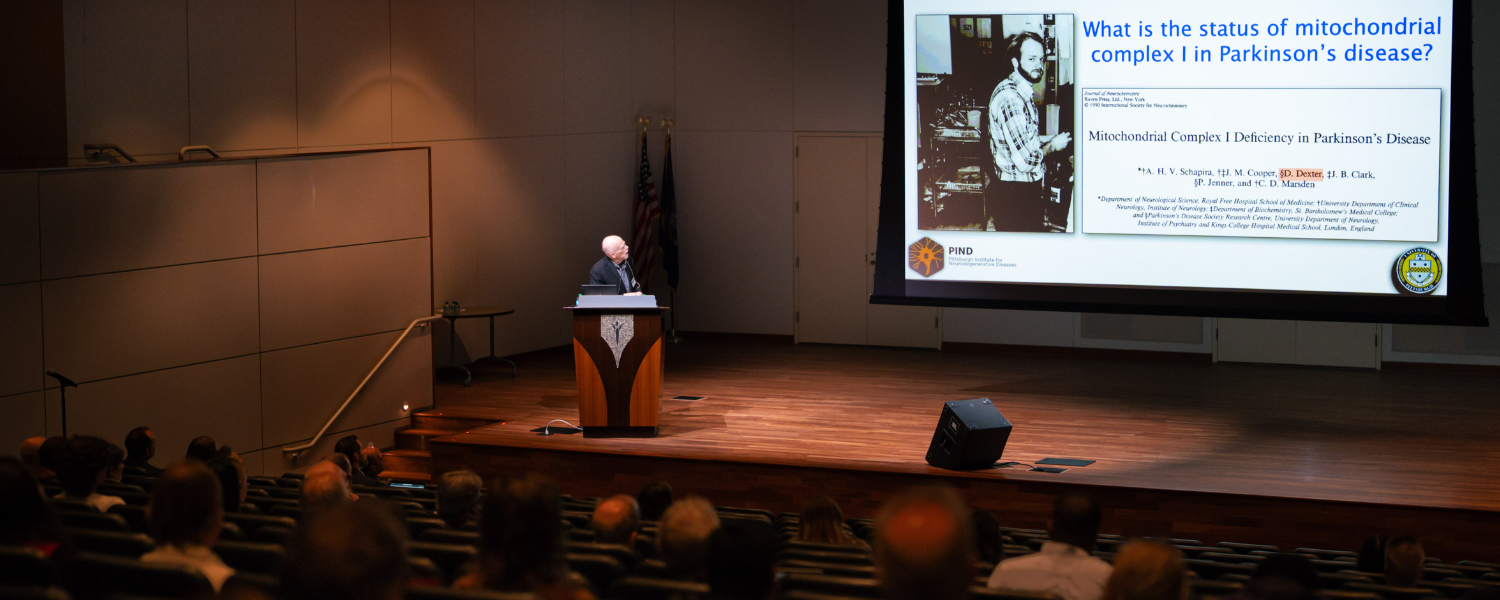Highlights from Grand Challenges in Parkinson’s Disease 2025
October 13, 2025

Here at Van Andel Institute, September marks more than the turn of the season: it signifies the return of our annual Grand Challenges in Parkinson’s Disease symposium and Rallying to the Challenge meeting.
These events bring together hundreds of scientists, clinicians and people with Parkinson’s to explore the latest Parkinson’s research. This year’s symposium focused on cell biology and highlighted the role of the endolysosomal pathway in disease (more on that below). In tandem, VAI and Cure Parkinson’s hosted Rallying to the Challenge, a meeting designed for and by people with Parkinson’s, advocates and care partners that explores how the Parkinson’s community can impact and accelerate research.
In case you missed the events, here are a few major takeaways:
The endolysosomal pathway has a major impact on Parkinson’s disease
Much like a recycling center, the endolysosomal pathway is responsible for cleaning up and recycling different types of materials within the cell. It comprises a system of organelles — tiny cellular versions of organs — that play key roles in cell survival by maintaining its internal environment. Because the endolysosomal pathway plays such an important part in cell health, problems with it can contribute to diseases like Parkinson’s.
Several symposium speakers discussed the latest research into LRRK2 and GBA1, a pair of genes known for their links to Parkinson’s. Both LRRK2 and GBA1 help maintain the structure and function of the organelles involved in the endolysosomal pathway and, when changes to these genes occur, it can lead to a buildup of misshapen alpha-synuclein within cells. These toxic proteins disrupt normal cell function and lead to cell death, ultimately contributing to the onset and progression of Parkinson’s disease.
Other speakers highlighted the role of mitochondria, one of the organelles that interacts with the endolysosomal pathway. Mitochondria are commonly known as the “powerhouses of the cell” because they generate most of the cell’s energy (and much more). As a result, mitochondria produce specific molecules that aid in cell communication and adaptation to stress. When there are problems with the mitochondria, production of these molecules increases, leading to a cellular imbalance and further contributing to the buildup of alpha-synuclein.
Looking to the future: The potential of combination therapies for targeting Parkinson’s progression
One of the grand challenges of Parkinson’s disease is its unpredictability: the disease can vary widely from person to person. These differences make it extremely hard to develop a universal treatment. As a result, scientists are exploring combination therapy approaches, which involve the use of two or more medications that work in parallel with each other. They can be paired to target separate pathways or enhance the effectiveness of the other.
One example is carbidopa/levodopa, which combines two common Parkinson’s medications. Levodopa works by crossing the blood-brain barrier and converting into dopamine, an essential chemical messenger that supports movement. Carbidopa prevents levodopa from being converted to dopamine too early and helps reduce side effects that can be caused by taking levodopa alone. Although combination therapies like carbidopa/levodopa treat Parkinson’s symptoms, no current treatments slow or stop disease progression.
Among participants of Rallying to the Challenge, this raised the question: might we use combination therapies to slow progression? In theory, combining medications could offer a one-two punch needed to more comprehensively treat individual disease. Although combination therapies often are used to treat cancer and other disorders, they have not been deeply explored in Parkinson’s. That’s changing, according to Cure Parkinson’s, and will be spurred on by a new funding program announced by the charity this summer (more on that here).
Many people with Parkinson’s already take a combination of medications to help manage their movement- and non-movement-related symptoms. It is critical, Ralliers said, that new disease-modifying combinations do not make that routine more challenging. Ultimately, the success of combination therapies will depend on how well treatments can be tailored to the unique biological landscape of each person with Parkinson’s.
Honoring excellence
During Grand Challenges in Parkinson’s Disease, VAI presented the Jay Van Andel Award for Outstanding Achievement in Parkinson’s Disease Research to J. Timothy Greenamyre, M.D., Ph.D., of University of Pittsburgh. Greenamyre’s pioneering research into the interactions between genes and the environment has vastly improved our understanding of Parkinson’s development and progression. The Jay Van Andel Award was established in 2012 in memory of VAI Founder Jay Van Andel, who battled Parkinson’s disease for a decade before his death in 2004. It is given to scientists who have made exceptional contributions to Parkinson’s disease research and who have positively impacted human health.
VAI and Cure Parkinson’s also honored University of Florida’s Matthew Farrer, Ph.D., with the Tom Isaacs Award, which recognizes a researcher who has significantly impacted the lives of people living with Parkinson’s and has involved them in their research. Farrer is widely known for his work in the genetics and neuroscience of Parkinson’s and focuses on uniting people with Parkinson’s and researchers for their mutual benefit.
To stay up to date on next year’s Grand Challenges in Parkinson’s Disease and Rallying to the Challenge meeting, please visit grandchallengesinpd.org.

